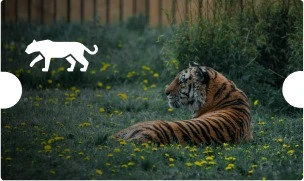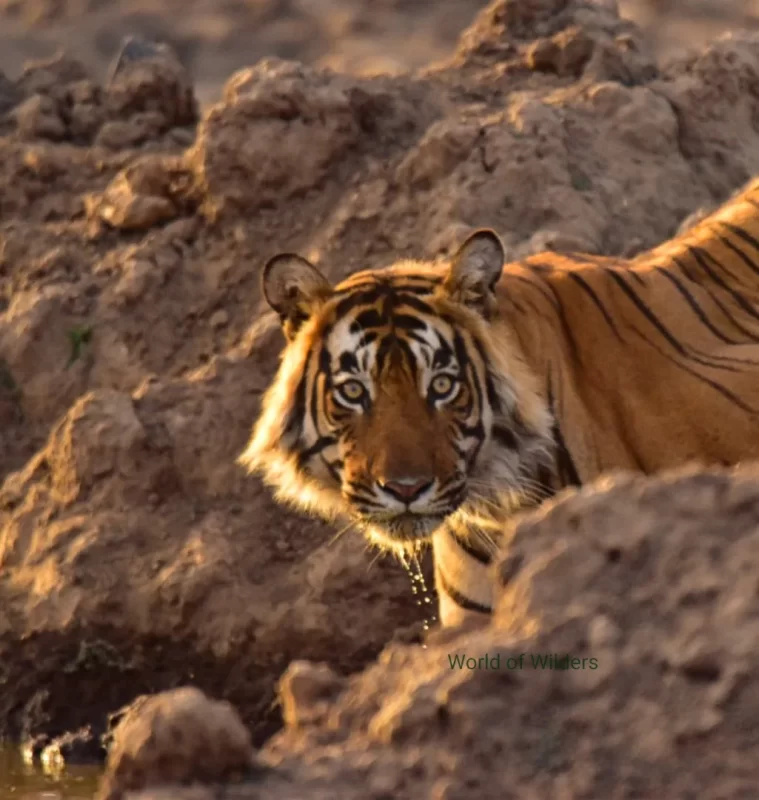Ranthambore Tiger Safari
Embark on an unforgettable journey through Ranthambore Tiger Reserve, home to majestic tigers
Starting From
₹1,350
Per Pax
Overview

Welcome to Tiger Safari City of Rajasthan ”SawaiMadhopur”. It was built as a planned city by Maharaja Shri Sawai Madhosingh from 1751 to 1768 and the city was named after him. The tiger reserve got its name from the majestic Ranthambore Fort built on a Aravalli hilltop right in the heart of the jungle which served as a hunting lodge for the Maharajas and other royal family members.
It’s Spread over an area of 282Sq Km and is one of the finest wildlife Reserves in the country for spotting tigers. One can easily record the majestic striped beauty sitting in a water body, walking on the road or just lazing under the morning sun during safari time. The Parks core area opens up for safari drives from 1st October to 30th June every year. The parks buffer area remains open round the year even during monsoons.
The reserve area is divided into the 10 Safari zones or routes and you can explore the wildlife in an open gypsy or canter in Morning or Afternoon shift as per booking availability. The Ranthambore Tiger Safari booking service is available for all the zones of the park. It is recommended to book safaris in advance for Ranthambore as limited vehicles are allowed to go inside per shift. All procedures of Ranthambore Safari booking for Jeeps and Canters are fully administered and managed by the state forest department.
Fast Facts:
- Late Rajput King Sapaldaksha of the Chauhan Dynasty laid the foundation of Ranthambore Fort during the mid-10th century.
- Ranthambore has been named after its famous 1000 year old Ranthambore Fort build by the erstwhile rulers.
- It was established as Sawai Madhopur Game Sanctuary in 1955, declared a Project Tiger reserve in 1973 and became a national park on 1st November 1980.
- The total area of Ranthmabore Tiger Reserve is 17000 Sqkm spreading over four districts.
- It is world driest Tiger Habitat with temperatures reaching upto 48Degrees Celcius.
- It has one of the largest banyan tree in the country.
- Machali (T-16) holds the title for most photographed tiger in the world.
- It is also famous for its lesser know species like Indian Pangolin, Indian Ratel, Indian Grey Wolf, Rusty Spotted Cat, Caracal etc.
- The parks core area is closed from July to September due to the monsoon season.
Flora
Ranthambore Tiger Reserve falls under the dry and deciduous forest category. It features a combination of dry tropical forests, lakes, streams, rocky terrain, and grassy meadows. Over 300 tree species, 40 shrubs, and 20 grass species are recorded here. The most dominant tree species is Dhok (Anogeissus pendula), thriving in both the Aravalli and Vindhyan Mountain ranges, and serves as fodder for herbivores. Bird life is supported by fruit-bearing trees like Banyan (Ficus bengalensis), Pipal (Ficus religiosa), Neem (Azadirachta indica), Mango (Mangifera indica), Gular (Ficus glomerata), Tamarind (Tamarindus indica), Jamun (Syzygium cumini), Ber (Zizyphus mauritiana), and Bor (Zizyphus nummularia). Other main trees include Khair (Acacia catechu), Dhak (Butea monosperma), Reonj (Acacia leucophloea), Tendu (Diospyros melanoxylon), Salar (Boswellia serrata), Babul (Acacia nilotica), Gum (Sterculia urens), Gurjan (Lannea coromandelica), Khajur (Phoenix sylvestris), and Kakera (Flacourtia indica).
Fauna
Ranthambore is the perfect habitat for close encounters with tigers, the apex predator here. Tigers are frequently sighted due to their diurnal and nocturnal behavior, meaning more daytime movement and sightings for visitors. The park is home to over 40 mammal species, including some very elusive, rare, and lesser-known mammals. Among the mammals, seven cat species recorded here are Leopard, Leopard Cat, Desert Cat, Caracal, Fishing Cat, Jungle Cat, and Rusty Spotted Cat, which is a record for having eight cat species in one reserve. Among canids, Golden Jackal, Indian Fox, White Footed Fox, and the rare Indian Grey Wolf are recorded. Other mammals include Striped Hyena, Sloth Bear, Indian Ratel, Palm Civet, Ruddy Mongoose, Rufous-tailed Hare, Indian Boar, Indian Pangolin, Rhesus Macaque, Indian Hedgehog, and Porcupine. Two species of deer, Spotted Deer and Sambar Deer, and two species of antelopes, the Indian Gazelle and the Bluebull (Nilgai), form the major group of herbivores here.
Over 330 species of birds (resident and migratory) are recorded, making it a paradise for bird watchers. Painted Spurfowl, Sarus Crane, Bronzed Winged Jacana, Sandpiper, Nightjar, Great Horned Owl, Dusky Eagle Owl, Painted Sandgrouse, Crested Serpent Eagle, King Vulture, Pitta, and Sirkeer Malkoha are some of the species that can be seen during safari time. The park is rich in herpetofauna, recording over 24 snake species and 12 lizard species. Forty-five species of butterflies and 50 species of spiders roam freely near the host plants. With such a huge list of species, you are bound to see not just the tiger but many other forest species as well. ecosystem.
Best Time To Visit
Winters are the best time to visit the park from October to March as the weather is optimum and you can see a lot diurnal activity by the big cats. Temperature can reach upto 3Degrees during peak winters.
Summers are equally a good time if you have photography in mind. As the grass and shrubs have dried up at this time and the jungle offers clear crisp photography opportunities. Temperatures can go really hot and high reaching upto 47Degrees Celcius making it difficult to step outside in the sun. However the chances of Tiger Sightings are relatively high during summers as you can see tigers lazing around near Water bodies during the day.
During monsoon the core are of the park remains closed and some zones in buffer area remain open. Sightings are relatively low at this time as there is ample drinking water everywhere, there is good grass or thick bushes canopy for the tigers to walk around unnoticed etc.
How To Reach
- By Air: Jaipur is the nearest International Airport around 180kms (2Hours 30Mintures Drive) from Ranthambore. Delhi is the second nearest International airport around 350kms (5Hours Drive with the new expressway). The airport is well-connected with domestic and international flights. Taxis and cabs are available at the airport for transportation. Pre-booking is recommended.
- By Rail: Sawaimadhopur is the nearest railway station around 7 kms from the Ranthambore Reserve Entry gate. If you wish to get down in a big city then Jaipur Station is the nearest. From Jaipur Junction to Ranthambore by train is just a 2 hour travel time in train (In some trains). Jaipur station is well-connected with major cities like Udaipur, Delhi, Mumbai, etc.
- By Road: Ranthambore is easily connected with the major Cities like Delhi (Via NH48 + NE4 Five Hours Drive) it’s 350kms, Jaipur (Via NH52+NH552 Two and Half Hours Drive) its 180kms, Bharatpur (Via NH21) it’s 243.5kms and Udaipur (Via NH27) it’s 406.8kms. These cities are further connected to major cities across India.
(You can use your own vehicle or book a Taxi service with us or opt for state bus services, pre book train services for a hassle-free journey.)
| INDIAN NATIONALS | ||
| GYPSY(max. 6pax) | CANTER(Max. 20 Pax) | |
| Price Per Person | 2050 | 1350 |
| Exclusive Vehicle | 12500 | 23200 |
| Foreign Nationals | ||
| GYPSY(max. 6pax) | CANTER(Max. 20 Pax) | |
| Price Per Person | 4200 | 2850 |
| Exclusive Vehicle | 22000 | 54475 |
| Period | Morning Trip | Afternoon Trip |
| 1 October to 31 October | 6:30 AM to 10:00 AM | 2:30 PM to 06:00 PM |
| 1 November to 31 January | 7:00 AM to 10:30 AM | 2:00 PM to 05:30 PM |
| 1 February to 31 March | 6:30 AM to 10:00 AM | 2:30 PM to 06:00 PM |
| 1 April to 16 May | 6:00 AM to 09:30 AM | 3:00 PM to 06:30 PM |
| 17 May to 30 June | 6:00 AM to 09:30 AM | 3:30 PM to 07:00 PM |
Booking Form
Know Before you Go
- Full permit fees must be paid in advance for safaris.
- ID proof is compulsory for every visitor and you must carry the same ID as provided during the booking process.
- Booking is non-transferable and cannot be exchanged with anyone.
- Passport details are mandatory for Non- Indians (foreign tourists) for reservation process.
- Indian Nationals can share any Valid Govt. Document like Adhaar, DL , Pan Card, Voter Id, Passport for reservation process.
- Safari permits are issued on a first-come first-served basis, subject to availability.
- In case your safari is not booked due to reasons like technical errors or non-availability of seats, we will refund the entire amount to your provided bank account. You will be informed accordingly.
- The park may be closed without prior notice to visitors by state forest department.
- In the event of any fee revision after booking, visitors will be required to pay the difference at the time of entry into the park.
- We act as a travel agent for booking your safari at the national park and will not be responsible for any accidents, injuries, thefts, or deaths during the safari excursion.
- Please note that the selection of safari driver or naturalist guide is not in our hands. It is determined by the automated roster system implemented by the forest department. If you require a choice vehicle or choice driver the same can be applied online at a government fees.
- As per the booking policy of the state government, approximately 140 vehicles (52 Canters and 88 Gypsies) can enter the park in one shift (as of June 1st, 2023).
- Visitors are required to report to the boarding place 30 minutes prior to the scheduled departure of the safari.
- Vehicle allotment (Boarding Pass) are issued on the same day as the safari date for afternoon drive and a day prior for morning drives as per government guidelines.
- Permits for Ranthambore can be done in Advance, Tatkal and Current Quota subject to availability.
- Advance Bookings can be done 90days prior to travel date, Tatkal bookings can be done 7 days prior to travel date and Current booking opens on same day for same day afternoon drive and next day morning drive.
- Once payment is made you will receive a call for confirming Zone availability for the said date and shift immediately.
- Safari in Ranthambore can be done in two vehicles Gypsy(6Seater) and Canter(20Seater).
- Pick Up and Drop from Hotel can be managed from the city subject to a nominal cost or guests can reach boarding point’s directly.
FAQ
- Both safari vehicles are good and have their own pros and cons. The choice of vehicle depends on the group size. If it's a large group, a canter is preferred, while a gypsy is preferred for a family of 4 or 6.
- Price-wise, the gypsy is more expensive than the canter, but it offers a more personalised experience.
- Availability-wise, canters are generally available near the date of travel, while gypsies are limited and rarely available without a 90-100 day advance booking.
- Structure-wise, both vehicles are designed for safari viewing and have open tops. The canter has the advantage of height and better vision, while the gypsy has the advantage of manoeuvring through narrow treks and roads.
In order to book safari online, we require Your Full Name, Gender and any one govt. authorized Identity card , i.e. Driving License, Adhaar etc. (Passport Number in case of Non-Indians) of each and every person travelling. Along with these details you also need to provide the date and shift of the safari. You also have to pay the full price of the safari booking in advance in our bank.
- There are 10 zones in Ranthambore.
- Zones 1 to 5 have a common entry gate located on Ranthambore Road, known as Ganesh Dhaam Entry Gate. After entering from the common entry gate, the safari vehicle further enters the allocated safari zone gate inside the reserve.
- Zones 6 to 10 have separate entry gates, which take more time to reach compared to Zones 1 to 5.
Safaris can be booked 90 days in advance.
As on March 2024 over 60 were recorded in Ranthambore.
Yes, it is suitable for children to go on a tiger safari. There is no entry fee for children below 5 years of age.
In the Ranthambore National Park, the safari timings are followed by the timings of the sunrise and sunset as the safari is only allowed half an hour after the sunrise till half an hour before the sunset. So, the safari entry timings vary with the change of the season.
Period
Morning Trip
Afternoon Trip
1 October to 31 October
6:30 to 10:00 AM
2:30 to 6:00PM
1 November to 31 January
7:00 to 10:30 AM
2:00 to 5:30 PM
1 February to 31 March
6:30 to 10:00 AM
2:30 to 6:00 PM
1 April to 16 May
6:00 to 9:30 AM
3:00 to 6:30 PM
17 May to 30 June
6:00 to 9:30 AM
3:30 to 7:00 PM
A. In order to book a safari online, we required the Full Name, Address, and Any Govt authorised identity card number such as voter id no., driving licence no., pan card no., etc. (passport number in case of foreigner tourist) of each and every person. Along with the personal details, you also need to provide the date and shift on which you want to do the safari. You also have to pay the full price of the safari booking in advance.
You need to pay the entire amount for the safari booking in advance. The safari booking is controlled by the government authority at Ranthambore National Park, and the safari is booked only after full payment. The confirmed safari booking is non-refundable, non-transferable, and non-adjust
- During summers, from April to June, temperatures can soar up to 45 degrees Celsius. It is recommended to carry ample drinking water, goggles, hats, a scarf, and preferred earthy-coloured cotton clothing.
- During the winter season, from November to mid-February, temperatures can drop to 2 degrees Celsius inside the reserve. It is highly recommended to carry heavy woollen jackets, warmers, ear muffs, and hand gloves.
Though both the Morning and Afternoon safaris offer the equal wildlife viewing experience and the tiger sighting can happen in both the shifts. But considering the chances of tiger sighting, the morning time has slightly better chances of tiger sighting than the afternoon time, as the tigers avoid the harsh sun rays and normally dont come out in open when the sun is strong. However, during the winter season, the afternoon safari offers the better chances of tiger sighting as you can find them basking in the sun in winter. So, you can say morning is better in summer and afternoon is better in the winter season.
The nearest railway station of Ranthambore National Park is SawaiMadhopur which is located about 14 km from the park.
Apart from Royal Bengal Tigers, many other wild animals are found in the park like Leopard, Caracal, Jungle Cat, Striped Hyena, Sloth Bear, Jackal, Desert Fox, Mongoose, Spotted Deer, Sambar Deer, Langur, Indian Mugger, Turtles and many beautiful colourful birds.
Pack light and comfortable clothing, binoculars, a camera, sunscreen, a hat, and mosquito repellent.
Yes! Infants are allowed in the Ranthambore safari. Many people take their babies on a safari, but you are advised not to go on a safari with infants because the crying and screaming of the children disturb the animals of the forest and disturb the tourists who accompany you.
Yes, you can choose the zone for safari in Ranthambore National Park but it completely depends on the availability of the safari at the particular time of booking.
Ranthambore Tiger Reserve has a total of 10 safari zones. Both the canter and the jeep go on the same track. All safari routes take you to the heart of the park and as such there are no bad zones. Each zone of Ranthambore has a tiger territory and seeing tigers in the forest depends on your luck and matter of chance, no matter which safari zone you visit.
The duration of a safari in Ranthambore National Park lasts for about 3 hours.
No, tourists are not allowed to carry food inside the park. Tourists are also not allowed to feed any type of food to wild animals.
No, pets are not allowed on safari in Ranthambore National Park.
No, you are not allowed to get off the safari vehicle in Ranthambore National Park. For this, the Forest Department has given permission to get off the vehicle at the forest check post only for nature calls at the provided facilities for tourists.
Trending Now
Experience the thrill of a Jhalana Leopard Safari and witness the elusive leopards in their natural habitat!
We're Also Providing
Experience the thrill of a Jhalana Leopard Safari and witness the elusive leopards in their natural habitat!

Book Cabs
Starts From ₹3000
View Details →

Book Flights
Starts From ₹8200
View Details →

Book Hotels
Starts From ₹3500
View Details →

Book Safaris
Starts From ₹1250
View Details →





